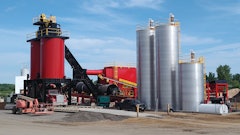Stronach Road, part of which is under the jurisdiction of the City of Manistee, MI and part of which is under Manistee County's jurisdiction, received a much-needed maintenance facelift this year by qualifying as an MDOT ARRA stimulus project. Through the Small Urban Program, which provides federal Surface Transportation Program (STP) funding for road and capital improvement projects to areas with a population of 5,000 to 49,999, both the city and county qualified for $190,000 to rejuvenate an approximate 5-mile stretch of the two-lane asphalt road.
According to Jeff Mikula, project manager for Abonmarche, the engineering firm hired to plan and oversee the project, a portion of the road is a rural truck route serving an industrial area on the outskirts of Manistee.
"The City of Manistee recently concluded an asset management analysis of its streets and part of the process involved exploring new techniques for repairing, upgrading and preserving its road network," Mikula says.
"Earlier this year the city decided to try a Hot In-Place with an ultra-thin hot mix asphalt (HMA) overlay on a 3.25-mile section of roadway," he continues. "They were happy with the results and the fact that they could preserve two to three times as much road system with the technique as compared to a mill and fill approach.
"So they decided to use the same preservation approach for the Stronach project," he says. "At the same time, the county's road commission expressed interest in the technique of rejuvenating the existing road surface and them capping it with a thin HMA overlay."
As a result, packaging the two sections of Stronach provided an economy of scales that improved the project's stimulus qualification chances. The original road structure consisted of full-depth asphalt with several layers of chipseal covering the surface.
"Because it does receive some heavy use from trucks traveling to and from the industries located along the road, the surface was starting to show some deterioration, but the base is in really good shape," notes Mikula. "Based on the city's previous experience with Hot In-Place covered by a thin overlay, we determined that this would be an appropriate solution for upgrading and preserving this particular road."
As for additional requirements because of ARRA funding, Mikula says the project had to follow the same requirements as any other federally-funded project.
"We had to perform some wedge work to correct the crown and slope of the road, as well as wedge work to widen a portion of the road where the shoulders dropped off, but that was basically it," he explains.
Project details
Rieth-Riley out of Traverse City, MI served as primary contractor on the project, performing all wedge work and placement of the ultra-thin HMA overlay. Gallagher Asphalt, Thornton, IL, performed the Hot-In Place work required to rejuvenate the aged surface layer prior to overlay placement.
"On that particular project we processed approximately 70,000 square yards of Hot In-Place recycling," says Pat Faster, who heads up Gallagher's Hot In-Place recycling division. "We heated and treated to a depth of 1 3/4 inches to correct any surface deformations prior to Rieth-Riley placing the ultra-thin overlay. This project completes the roughly half million square yards of Hot In-Place recycling we performed in Michigan this year."
After Gallagher finished its preservation work, Rieth-Riley placed 1,300 tons of wedge mix to build up the shoulders on a portion of the project, and then applied a tack coat before placing 4,000 to 5,000 tons of a low (traffic) volume Superpave ultrathin mix.
"The project specification called for 82 pounds of the ultra-thin mix per square yard of surface in order to achieve the ¾-inch mat thickness requirement," explains Jeff Saylor, Rieth-Riley project manager. "We did a couple of these ultra-thin projects last year and they really turned out well. The mix consists of finer aggregate and it really compacts smooth and tight."
The ¾-inch overlay is designed with low aggregate count - 100% of material has to pass through a ½-inch sieve.
According Jim Johnson, project engineer, the ultra thin mix specified for the project is a commercial ADT (average daily traffic) design requiring a PG 64-28 polymer modified binder. The MDOT commercial ADT mix is designed for average daily traffic counts of up 3,400 commercial vehicles.
"It's a surface rating and not a subbase requirement," Johnson notes. "Three years ago MDOT used the same ultra-thin mix on a county road used as a detour and they liked how well it held up. So that's what was specified for this project.
Without the stimulus funds, it's unlikely Stronach Road would have been completed this year.
"The road commission did complete a similar Hot In-Place/ultra-thin overlay project on a 3 1/4-mile road earlier this summer and had identified Stronach Road as an ideal candidate for the process, but the funding was just not there," Mikula says. "The total project was estimated to cost $482,000 and without the $190,000 stimulus funds received, there's no way we could have moved forward with the work this year."
Of ARRA's $27.5 billion allocated for road and bridge projects, MDOT expected to qualify for $850 million. Through the Small Urban Program, MDOT determined that approximately $12.9 million would be available to fund small projects similar to the Manistee road preservation completed this fall.
According to all the parties involved in the preservation project, there was some additional documentation required for the stimulus funding, but the funds received proved to be very beneficial in turning the project into a reality.


























